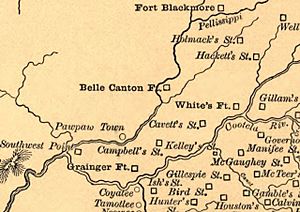Bob Benge facts for kids
Robert "Bob" Benge (born around 1762–died 1794) was an important Cherokee leader. People also knew him as Captain Benge. He lived in the Upper Towns, which is now part of Southwest Virginia. Bob Benge was active during the wars between the Cherokee and American settlers from 1783 to 1794.
Contents
Early Life of Bob Benge
Bob Benge was born about 1762 in the Overhill Cherokee town of Toqua. His mother was Cherokee, and his father was John Benge, a trader from Scotland and Ireland. John lived with the Cherokee and had a "country wife," which meant he was married in the Cherokee way. Bob also had a sister named Lucy.
Bob Benge had red hair, which he got from his father. This made him stand out. In the Cherokee culture, children belonged to their mother's family and clan. This system is called matrilineal kinship. The mother's oldest brother was a very important male figure, especially for boys. Bob and Lucy grew up in Cherokee culture and saw themselves as Cherokee.
It is believed that Bob and Lucy were half-siblings of Sequoyah, who created the Cherokee writing system. They were also related to important leaders like Old Tassel and Doublehead.
In 1777, a Cherokee leader named Dragging Canoe moved his people southwest. John Benge also moved his family to Running Water. This was one of the Lower Towns in the Piedmont area.
When Bob Benge, his half-brother 'The Tail,' and his cousin Tahlonteeskee were about 20 years old, they became warriors. They joined their uncle John Watts to fight against American settlers. These settlers were moving onto Cherokee lands after America won its independence from Great Britain.
Fighting for His People
While living at Running Water, Bob Benge met members of the Shawnee group led by Cheeseekau and his brother Tecumseh. Benge often joined them on their raids against the Americans. In one early raid in 1777, Benge is said to have captured two women near Fort Blackmore, Virginia.
Later, he often fought with warriors led by Doublehead. They came from Coldwater Town, near Muscle Shoals on the Tennessee River. Benge is known for saving the people of Ustally in 1788. American leader John Sevier had planned to destroy that town.
Benge led raids far north to the Ohio River. He also went deep into southwestern Virginia, all of North Carolina's Washington District, and southeast into Georgia and South Carolina. He even joined Doublehead on a raid into the Kentucky hunting grounds.
The Brown Family Rescue
Bob Benge was at Running Water when he heard that the Cherokee had agreed to exchange captives with John Sevier. The Brown family was mentioned by name. They were settlers captured in 1788 near Nickajack.
Only three of the Brown family members were still with the Cherokee. The other three had been given to the Muscogee people. Joseph Brown and his sister Polly were brought to Running Water right away. But when messengers went to Crow Town to get Jane, their youngest sister, her owner refused to give her up.
Benge got on his horse and grabbed his famous axe. He said, "I will bring the girl, or the owner's head." The next morning, he returned with Jane. The three Brown children were later given to Sevier at Coosawattee.
Cavett's Station Incident

Bob Benge and his close ally, Doublehead, had a serious disagreement at Cavett's Station. In 1793, John Watts led a raid on settlements along the Holston River. Their target was White's Fort (now Knoxville, Tennessee).
At Cavett's Station, Benge made a deal for the people inside the small fort to surrender. He promised them safe passage. But Doublehead and his group broke this promise. They attacked and killed everyone—men, women, and children—as soon as they left the fort. Benge, Watts, and James Vann begged them to honor the agreement, but Doublehead refused.
After this terrible event, Benge never worked with Doublehead again. This incident also caused a lasting disagreement between Doublehead and Vann. It led to a split between the Upper and Lower Towns after the wars ended in 1794.
Death of Captain Benge
Benge continued to lead raids as far as the western parts of Virginia. He attacked Gate City, Virginia in 1791. He also raided Moccasin Gap and Kane's Gap on Powell Mountain in 1793.
On April 6, 1794, Bob Benge was killed in an ambush. This happened in what is now Wise County, Virginia. He was deep in enemy territory, taking captives from a settlement back to the Lower Towns. The local militia took his scalp and sent it to the Governor of Virginia, Henry Lee III. The governor then sent it to President George Washington. Vincent Hobbs Jr., a militia leader, was given credit for killing Benge.

